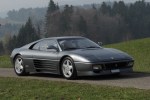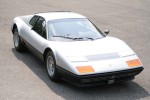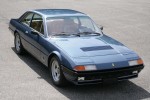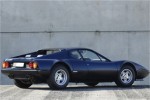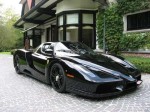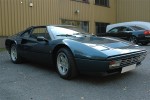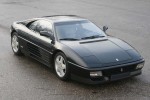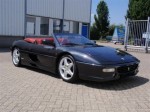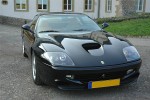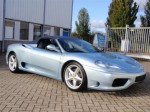Ferrari Testarossa
- 1991
- 49.000 km
- Original
- EU title
- CH/EU taxes paid
- Sold
This Rosso Corsa over Tan Ferrari Testarossa has been sold to France.
Whenever great Ferraris are being discussed the name Testa Rossa is inevitably brought up. Exactly why Ferrari chose to use red paint on the cam covers of the new 2-litre 4-cylinder sports/racing Ferrari of 1956 and call the car the 500 - Testa Rossa - is not known. But the distinctive engine feature and the name was continued when, in late 1957, the 250 Testa Rossa, a 3-litre V-12, was introduced.
The Testa Rossa provided some of Ferrari's greatest moments on the racetracks of the world. In a continuing homage to the past after de Mondial and GTO, it came as no surprise that Ferrari would recycle the name Testa Rossa.
The new Testarossa - written as one word was introduced at the Paris Auto Show in October of 1984. Unlike its ancestral namesakes it was not intended for racing, but rather for normal road use. But in its own way it was a very important model for Ferrari as, among other things, it took the legendary 12-cylinder Ferrari back to America on an official basis. It had been over ten years since Ferrari had last had a 12-cylinder car, the 365 GTB/4 Daytona, available for sale on that side of the Atlantic.
At first observation the new Testarossa looked to be nothing more than a continuation of the Berlinetta Boxer series. Closer examination of the particulars, however, revealed that such was not the case.
There was no doubt that the styling of the Testarossa was a complete departure from the old BB aesthetics. Designed, of course, by Pininfarina, the Testarossa's shape relied heavily on aerodynamic considerations. One early observer of the shape made note of the fact that the shape was noticeably devoid of such aerodynamic devices as wings. - The whole car is a wing - he stated, which was verified by the CZ - negative lift - and CX - aerodynamic coefficient - numbers.
Even the rear-view mirror's design was studied in the wind tunnel. Some of the stylistic features were also dictated by the revised layout of the chassis. For numerous reasons, such as better balance, cockpit comfort and increased luggage space the engine cooling radiators were moved from the front to the centre rear of the car. This in turn led to the distinctive finned air intakes on the flanks. But as with any car designed by Pininfarina, aesthetics were also a major consideration. As a result, the design of the new Testarossa was both pleasing and efficient.
Mechanically the car was also virtually brand new while retaining the basic architecture of the BB's - that is a flat-12 - boxer - motor of just under five litres mounted just ahead of the rear axle, and a typical Ferrari tubular chassis. But the engine had been significantly improved. First of all, it was some 20-kg lighter. Secondly, it produced significantly more horsepower and more torque than before.
Much of this improvement could be attributed to the adaptation of the four valves per cylinder technology derived from the Formula One engines and introduced in 1982 on the 308 Quattrovalvole. Bosch KE-Jetronic fuel injection and Microplex type ignition completed the package. Not only was the engine more powerful, it was also more fuel efficient and as a result also cleaner, making it easier to bring into compliance with U.S.A regulations.
Interior comfort was likewise enhanced. Moving the radiators to the rear helped keep the cockpit cooler and allowed for a front air vent. The interior was in full Connolly leather, the seat backs were infinitely adjustable, and the steering wheel was now also adjustable. The dashboard layout was redesigned with only the main instruments being located in front of the driver. The odometer, fuel indicator and oil temperature gauges, along with the clock, were located on the upper console, while the lower console contained the various control switches and knobs. Of course, all amenities such as air conditioning, power windows, etc. were standard.
An increase in wheelbase, from 2500mm to 2550mm, was required by moving the water and oil tanks from the front to the centre rear and relocating the petrol tank to between the engine and the cockpit. This, of course, further improved the balance of the car.
The suspension was - near race-quality - with tubular steel double wishbones, helical springs, telescopic shock absorbers and stabiliser bars front and rear. The disc brakes were 12 inches in diameter. The five-spoke centre-lock 16 inch alloy wheels were 8 inch and 10 inch wide front and rear. The rack and pinion steering was not power assisted. Finally, the five-speed plus reverse gearbox with limited slip differential had a hydraulically operated clutch whose diameter was increased from 8 1/2inch to 9 1/2 inch.
The Testarossa proved to be very popular, helped by its impressive performance - the factory figures of 178 mph top speed and 0-60mph time of 5.7 seconds were easily confirmed by magazine road testers who likewise praised the car's driveability. In fact, it is hard to find any negative comments. The most common concerns were the size - it was quite wide - and the typical Ferrari anachronisms.
It became the all-time best-selling Ferrari model during its seven full years of production with 7,183 units made - some sources place the figure as high as 7,589 -. Of these just under 2,000 were made for the North American market. The production run, from October 1984 until the end of 1991, happened to coincide with the great boom in the Ferrari market. Although detail improvements were constantly being made throughout the production run of the Testarossa, only two really noticeable changes took place during the seven years. In late 1986 the single, high-mounted, rear-view mirror gave way to new, low-mounted, dual mirrors which, in turn, required a rearrangement of the console controls.
According to a factory technical bulletin, the last of the single mirror cars was S/No.67077 and the first of the dual mirror cars was S/No.67079. Then, in early 1988, the centre-lock wheels were replaced by five-bolt wheels. Again, according to factory technical bulletins, the first Testarossa's to receive the new five-bolt wheels were S/No.75997 (RHD), S/No.75998 (USA) and S/No.76004 (LHD European).
The Ferrari Testarossa leaped to center stage of the automotive world in 1984 and retained the spotlight even after production of its final variant ceased in 1996. Through those 11 years, the Testarossa sat atop Ferrari's road car line, and for most of that time it was the fastest regular production car in the world. It was the definition of - supercar - in its era, the benchmark against which all contemporary sports cars were measured. Styled and designed with innovation, all subsequent Ferraris can trace some important development to the Testarossa.
The car even became an international television star, upstaging other both human and automotive players on Miami Vice, a series whose peak of influence and popularity coincided with the adoption of a Testarossa as primary transportation by its main characters. And yet it was equally at home and appreciated at the opera or the race track. Few cars exert such power both on the road and off. In any context or location, the Testarossa makes a bold statement and sets an exciting tone.
A smooth and powerful V12 engine has always resided at the pinnacle of Ferrari's product line; a two seat car with as much performance as an owner could use and with a degree of practicality.
The Testarossa's look is assertive rather than aggressive, friendly rather than fearsome. Traditional Ferrari traits such as the eggcrate grille and taut flowing lines were successfully mated with new stylistic touches such as rectangular rear lights and the broad, squared rear flanks. The flanks of the cabin were designed both to enhance the lines of the car and function as aerodynamic and cooling aids.
Early Testarossas had a single mirror located halfway up the driver's side A-pillar, at the end of two long, thin stalks. This design placed the mirror level with the driver's head. Dual stalks used the airstream to keep the mirror clear during rain, and reduced noise. Within two years, all Testarossas had mirrors on both sides, located by shorter dual stalks.
The Testarossa's most indelible image is of the five body color strakes that cover the side intakes and stretch between the ridges just below the door mirrors. The strakes are almost parallel, each one curved a little more along the line of the upper ridge than the one below it. The strakes are invisibly broken at the rear edge of the door where a vertical support holds them rigid. After the support, the rear strakes seem to disappear into the sidepods. The strakes smooth and direct the airflow into the sidepods. They also protect the cabin and sidepods from intrusion.
The Testarossa's old and new forms fused to create a unique car with immediate visual impact and appeal without sacrificing functionality.
The primary requirement for the Testarossa's interior was that it be more practical, spacious and luxurious than the Berlinetta Boxer it replaced. It was fitting that Ferrari's premier car should be comfortable as well as fast, that passenger and driver alike should be cosseted even within the confines of a small sports car. The Testarossa's designers easily met their brief and with each evolution exceeded it further. The interior was improved and refined, always maintaining its position as the most modern sports car cockpit in the world.
The Testarossa's cabin is bounded on either side by wide sills to accommodate the doors. To the rear, the firewall separates the cabin and engine bay. Built into the firewall is a carpeted luggage shelf extending forward to the seat backs. The seats are snug and well bolstered, though each cushion appears to be flat. They are upholstered in Connolly Leather and the high, flat head rest has a prancing horse embroidered at its center. The seats are electrically adjustable. The handbrake lever and releases for the hood and engine cover are between the driver's seat and doorsill. At the front of the cabin, Pininfarina made good use of the intruding wheel wells by mounting large stereo woofers facing the occupants. Like the seats, the doorskins of the Testarossa are covered with luxurious leather extending even to the door pulls. Occupants are afforded maximum comfort by the interior design of this premier touring machine.
From the top of the front bulkhead hangs the leather covered dashboard. The shallow dashboard has a horizontal top which slopes into a vertical front. On the top are windshield defogger vents, and on the front are climate control vents. The stereo is mounted behind a hinged door above the center console. The console holds gauges and status indicator lights, arranged vertically and angled towards the driver. These include indicators for oil temperature, fuel, time and distance travelled. Commanding the console is the traditional slender gear lever in its polished gate.
The low rectangular instrument binnacle extends towards the driver from the sloping dash section. The large speedometer and tachometer gauges dominate the split black facia. A purposeful 300 Km/h speedometer, 10000rpm tachometer, oil pressure and coolant temperature gauges are prominent in the hooded binnacle. Various indicator lights are offset around these orange and white on black gauges. Beneath the instruments the adjustable steering column extends a thin rimmed, leather covered, three spoke Momo steering wheel towards the driver.
Along with the luggage shelf behind the seats, the Testarossa offers carpeted cargo space beneath the front hood. This compartment isa deep cruciform, providing room for shopping or luggage. The carrying capacity of the Testarossa in the front and passenger compartments is maximized by use of fitted Schedoni luggage, an option available from Ferrari dealers.
The Testarossa chassis consisted of square section steel tubes arranged in a strong matrix, like a racing car. This was Ferrari's normal practice in chassis construction until the late 1990's. The Testarossa had a full tube steel chassis with a removable rear sub-frame containing the drivetrain and rear suspension. This gave the heavy rear of the car a double layer of support and simplified mechanical service. Vertical bulkheads at either end of the passenger cabin were of strengthened galvanized steel. The floorpan and front luggage bin were semi-monocoques bolted to the tubular chassis. The result is a passenger cabin with unsurpassed safety and an extremely rigid platform for a car with superlative performance.
The compactness of the flat 12 engine allows it to be mounted very low within the rear sub-frame. This lowers the center of gravity and the polar moment of inertia, meaning the safe limits of the car's handling are very high. The car was also given dual fuel tanks mounted transversely between the passenger and engine compartments. This design ensured the car remained evenly balanced as fuel was consumed. The form of the engine and even the fuel system complements the design of the chassis and raises the safe performance level of the Testarossa.
The 1991-94 model has a floor pan strengthened at high stress points by chromium-molybdenum steel. New welding techniques strengthened joints. The drivetrain and rear suspension were directly mounted on the full rear frame. These changes contribute to substantially increased torsional rigidity and decreased weight.
It was given even larger brake discs, not only vented but cross drilled for improved efficiency. The brake calipers complemented the new discs with larger pistons. The brake system proportioning valve was also revised to improve control and reduce pedal effort. Late versions were equipped with an anti-lock braking system. The steering column was revised, and the rack changed to provide quicker steering and tipped the scales 88lbs less. In all, the changes were extremely successful.
The 1995-6 model received some minor chassis tweaks and Bosch ABS was standard.
The front suspension consists of a coil spring over a Koni shock absorber located by unequal, length dual wishbones at each front wheel. At the rear, dual unequal length steel wishbones locate a pair of coil springs over Koni shocks, one fore and one aft of each driveshaft. Front and rear anti-rollbars maintain stability in high speed cornering. The Testarossa's brakes are vented discs a little over a foot in diameter. The hydraulically assisted four piston calipers are controlled by separate circuits front and rear. The parking brake acts on small drums contained within the rear discs. The unassisted steering is by a direct rack and pinion system.
Lighter springs, revised shock absorber valving and changes to the wishbones helped make the later models somewhat more nimble and comfortable. This is a testament to good design given that the newer car is also more powerful.
With the loss of the removable rear sub-frame, the engine and drivetrain of the last models were mounted even lower in the car, further improving the handling.
The Testarossa's one piece cast alloy wheels are dull silver. On early cars, the wheels were secured by large closed nuts, but these soon gave way to five hub bolts. The wheels have five spokes in the shape of a star. The front wheels measure 16"X8" and carry a 225/VR50 tire. The rear wheels measure 16"X10" and carry tires 255/VR50 in size.
To fully exploit its power, the 512TR was also given new cast alloy wheels. These wheels are thinner spoked versions of the Testarossa's, for improved brake cooling. The five hub bolts remain. These wheels are 18"X8" with 235/ZR40 tires at front, and 18"X10.5" with 295/ZR35 tires at the rear. Though the same size as those of the 512TR, the wheels of the F512M are split rims with curved spokes resembling a propeller.
Ferrari's Testarossa was created to be the fastest and most competent Grand Touring car in the world, a combination of comfort and speed. The rigid race bred chassis and suspension and opulent interior ensured the high level of comfort.
The best and most reliable powerplant Ferrari could devise ensured grace and speed. Because it was to replace the 512 Berlinetta Boxer Iniezione as the company's premier two seater, there was little doubt the Testarossa would be powered by a twelve cylinder engine; beyond that, the choices were wide open.
Ferrari chose to develop the512BBi's engine, which had yet to reach its performance potential. The Testarossa thus has a horizontally opposed cylinder configuration, known as a "flat", "boxer" or "180 degree vee" design. Major advantages of this design include compactness of height, high torque and natural damping of vibrations.
The Testarossa's longitudinally mounted flat twelve is a 4942cc all alloy unit with four valves per cylinder actuated by dual overhead cams. The bore is 82mm, the stroke 87mm. On North American cars, the engine's compression ratio is 8.7:1. The aluminum pistons move in nikasil cylinder liners and rotate a seven main bearing, hardened steel, billet turned crankshaft via forged steel connecting rods.
The combustion chambers are ellipso-hemispherical. The camshafts are driven from the crankshaft by toothed belts with tensioners, and actuate valves inclined from each other at 41 degrees. Fuel is metered by two Bosch KE Jetronic systems, one for each bank of cylinders, and delivered to the fuel injectors through a pair of Bosch electric pumps.
Air is delivered to the engine through the air filter and intake manifolds from a tray mounted beneath the center rear of the rear decklid. Spark is provided by a pair of coils and with their own distributors, controlled by a Weber-Marelli Microplex ignition system. The combusted mixture flows out through tube steel exhaust manifolds, catalytic converters and a tuned exhaust system.
The engine is cooled by a compact system of twin radiators and a single water pump. The pump is a centrifugal type, driven from the crankshaft by a double chain. The side mounted radiators each have a large thermostatically controlled Spal fan to maintain optimal efficiency under all conditions. The engine is lubricated by a dry sump system in which a scavenger pump transports oil from the sump to the tank through an oil cooling radiator on the right side of the car. From there, the oil is returned to the engine by a pressure pump.
The rated power of the North American Testarossa is 380bhp at 5750rpm, and354lb-ft of torque is created at 4500rpm. Because of its compactness, the engine sits very low in the Testarossa's chassis, improving handling while contributing power.
The Testarossa's transmission is a work of superior design. It is a compact system sited directly beneath and in unit with the car's engine. There are five forward gears and one reverse, all syncromesh. Drive is transferred from the flywheel through a dual plate hydraulically actuated clutch at the rear of the engine. It is turned through one hundred and eighty degrees to the gears beneath the engine, and then returned to the driveshafts through an integrated limited slip differential. The flywheel and clutch are behind the differential and driveshafts, the gears are ahead. The transmission is actuated from the shifter by steel rods. The gear ratios are close, with fourth and fifth being fairly tall.
The later models saw some minor drivetrain alterations. It was given a new single plate clutch, and a new transfer gear. The transmission was basically unchanged, though the gear and final drive ratios were lowered. This helped improve acceleration; notably, it did not reduce terminal speed. As with its engine, the transmission also enjoyed small improvements. The synchronizers were changed to handle the increased power, and the clutch slave cylinder was redesigned. The shifter mechanism was also modified to improve the speed, ease and precision of shifts.
Throughout the production life of the Ferrari Testarossa and its variants, the constantly improving flat 12 engine and its ingenious transmission ensured that Ferrari's premier production grand touring car was a top performer. Rarely out of the highest position in comparisons of top speed, the Testarossa line was often able to out accelerate cars which were designed for optimal acceleration. Given that its primary brief was as a Gran Tursimo which could also provide comfortable transportation, the Testarossa and its descendants bring to the table impressive credentials as a pure performance cars.
“ your classic auto specialist; world-wide collector car expertise ”
We buy, sell, broker, locate, consign and appraise exceptional classic, sports and collector automobiles, arrange transport, customs formalities and registration.
Jaguar, Ferrari and Maserati expertise, though our collection includes a wide variety of other superior antique, vintage, prewar and race cars.
Contact us when you are serious about owning or selling a fine classic motor car or motorcycle. Geneva, Switzerland-based, we serve clients world-wide.
Chemin des Tulipiers | 1208 | Geneva | Switzerland | +41 (0) 787.055.745































